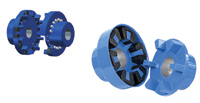
Posted to News on 21st Sep 2019, 00:00
The benefits of pluggable claw couplings
Torsionally flexible claw couplings have amassed a multitude of installations in many demanding environments. David Proud of Reich Drive Systems explains why.

Pluggable claw couplings have undergone many updates over the decades, enabling them to maintain their reputation as a key drive technology. And the number of different types means there is invariably a pluggable claw coupling for every type of application.
The capabilities of pluggable claw couplings are typified by the Multi Mont range from Reich Kupplungen – a clever and easily customised concept for connecting shafts within a drive train to transmit torque. The full Multi Mont range covers a vast torque capacity from 40Nm right up to 1,000,000Nm, using the GIGANT version, which is at the top end of the product offering.
Irrespective of model selected, the main benefit of the Multi Mont family of couplings is the ability to change the flexible transmission elements without the time consuming work required to move machinery and then realign it afterwards. There is no need to uncouple the drive, as each variant is designed to allow easy access to the flexible transmission elements, which can then be removed and replaced radially. This concept generates considerable savings in time over alternative product types, helping to maintain the highest levels of uptime and efficiency.
The Multi Mont standard range utilises Spheroid Graphite (SG) Iron for the hubs and flanges. SG Iron offers greater elasticity, resulting in a better and more robust coupling which is less susceptible to damage. The range also allows the incorporation of keyless clamping elements, either internal locking assemblies or external shrink discs. The keyless clamping method of locating a coupling hub on to a shaft offers many distinct advantages over traditional methods such as keyways, splines and thermal shrink fits.
Depending upon the individual product variant, a natural/synthetic rubber mix or nitrile rubber is used for the flexible transmission elements. Natural rubber is proven to be the best material for damping, so Multi Mont couplings are ideally suited to applications where torsional vibration is present. Standard flexible elements have a temperature range of -40°C to 100°C, and for higher temperatures silicone elements with temperature range of -70°C to 120°C are available.
Over the decades, Reich Kupplungen has developed the Multi Mont flexible jaw coupling into a versatile product with many variants as standard, including: shaft to shaft; shaft to flange; flange to flange; with brake drum or with brake disc versions, and also a standard version with the very popular taper bush centre.
Innovations around the Multi Mont flexible jaw coupling continue with the recent development of a high-speed version made from high-grade aluminium, which is capable of speeds up to 20000rpm.
Designers and engineers have taken advantage of the unit’s adaptable design to easily combine the coupling with other mechanical power transmission products such as torque limiters, clutches, freewheels and fluid couplings to create bespoke drive solutions. Customers who have demanding applications requiring ATEX certification can now specify the new standard ATEX Multi Mont Sella flexible jaw coupling.
Given the extensive nature of the product range, and its impressive heritage, it is not uncommon to find examples of Reich’s Multi Mont couplings being used in many challenging applications within marine, off-road vehicles, pumps and compressors, quarry equipment and other general industrial roles. And the growing demand for electric and hybrid drive vehicles has seen the Multi Mont range diversify yet further, where it can be found at the heart of many new drive and propulsion systems.
Coronation Street, Unit 4
Bankside Business Park
SK5 7PG
UNITED KINGDOM
+44 (0)161 474 0464










